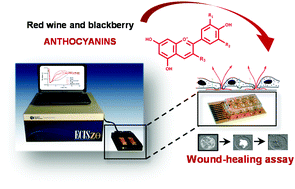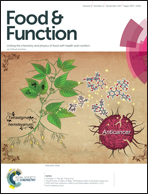The effect of anthocyanins from red wine and blackberry on the integrity of a keratinocyte model using ECIS
Abstract
There is a growing market demand for the incorporation of plant-derived ingredients into new products for the cosmetic industry. Anthocyanins are polyphenols arising from plant secondary metabolism that have been shown to possess many bioactive properties such as free radical scavenging, antimicrobial, and chemopreventive activities. In this work, the biological activities of red wine and blackberry anthocyanins were assessed by developing a new keratinocyte barrier model using the HaCat cell line and a microelectrode-based biosensor device, referred to as Electric Cell–Substrate Impedance Sensing (ECIS). Cells were seeded at the optimal cellular density of 1.6 × 106 cells per mL and the half-time was calculated to be 3.55 ± 0.67 hours. The compounds’ cytotoxicity was assessed and anthocyanin pigments showed no cytotoxicity towards keratinocyte cells. Wound healing assays were also performed using ECIS and it was observed that the tested pigments enhanced the healing rate of keratinocyte cells by reducing the healing time more than 50%. Cyanidin-3-glucoside presented the best results recovering 50% of the injured area in 1.48(±0.15) hours, followed by the blackberry anthocyanins (2.01 ± 0.18 hours), malvidin-3-glucoside (2.03 ± 0.09 hours) and red wine anthocyanins (2.36 ± 0.76 hours). All presented significant differences from the control 4.91(±1.11) hours.



 Please wait while we load your content...
Please wait while we load your content...